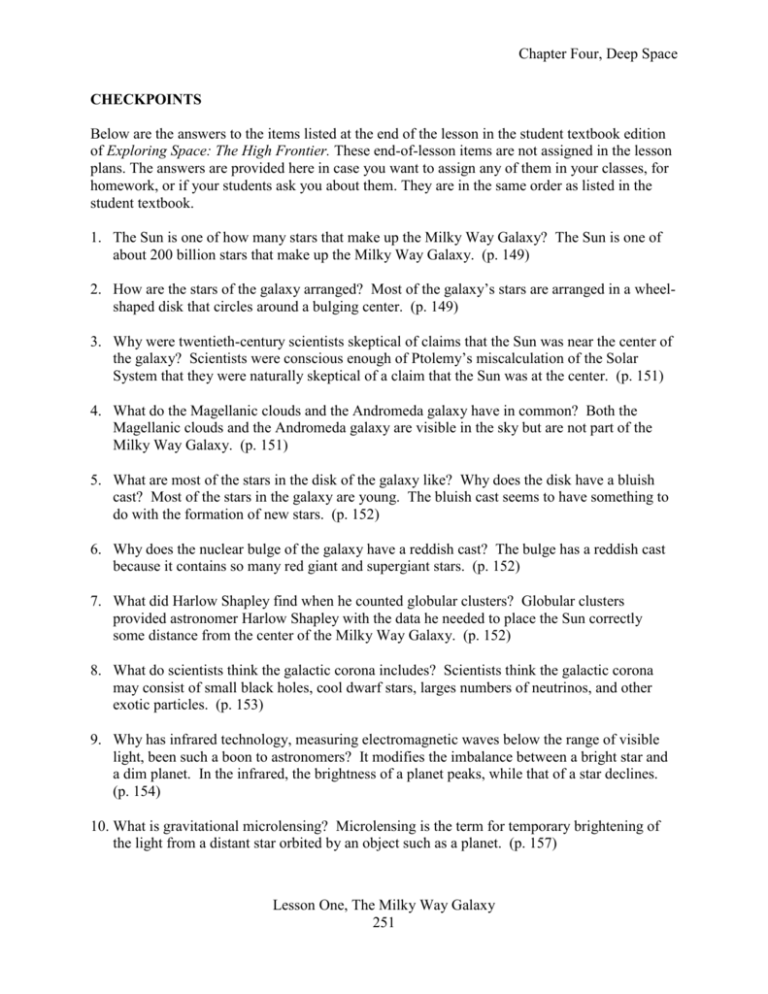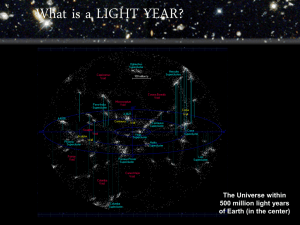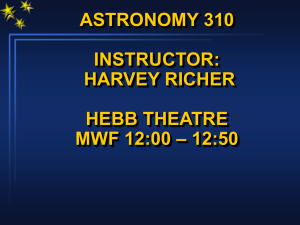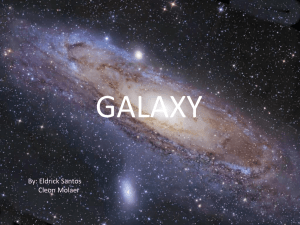LESSON PLAN 3
advertisement

Chapter Four, Deep Space CHECKPOINTS Below are the answers to the items listed at the end of the lesson in the student textbook edition of Exploring Space: The High Frontier. These end-of-lesson items are not assigned in the lesson plans. The answers are provided here in case you want to assign any of them in your classes, for homework, or if your students ask you about them. They are in the same order as listed in the student textbook. 1. The Sun is one of how many stars that make up the Milky Way Galaxy? The Sun is one of about 200 billion stars that make up the Milky Way Galaxy. (p. 149) 2. How are the stars of the galaxy arranged? Most of the galaxy’s stars are arranged in a wheelshaped disk that circles around a bulging center. (p. 149) 3. Why were twentieth-century scientists skeptical of claims that the Sun was near the center of the galaxy? Scientists were conscious enough of Ptolemy’s miscalculation of the Solar System that they were naturally skeptical of a claim that the Sun was at the center. (p. 151) 4. What do the Magellanic clouds and the Andromeda galaxy have in common? Both the Magellanic clouds and the Andromeda galaxy are visible in the sky but are not part of the Milky Way Galaxy. (p. 151) 5. What are most of the stars in the disk of the galaxy like? Why does the disk have a bluish cast? Most of the stars in the galaxy are young. The bluish cast seems to have something to do with the formation of new stars. (p. 152) 6. Why does the nuclear bulge of the galaxy have a reddish cast? The bulge has a reddish cast because it contains so many red giant and supergiant stars. (p. 152) 7. What did Harlow Shapley find when he counted globular clusters? Globular clusters provided astronomer Harlow Shapley with the data he needed to place the Sun correctly some distance from the center of the Milky Way Galaxy. (p. 152) 8. What do scientists think the galactic corona includes? Scientists think the galactic corona may consist of small black holes, cool dwarf stars, larges numbers of neutrinos, and other exotic particles. (p. 153) 9. Why has infrared technology, measuring electromagnetic waves below the range of visible light, been such a boon to astronomers? It modifies the imbalance between a bright star and a dim planet. In the infrared, the brightness of a planet peaks, while that of a star declines. (p. 154) 10. What is gravitational microlensing? Microlensing is the term for temporary brightening of the light from a distant star orbited by an object such as a planet. (p. 157) Lesson One, The Milky Way Galaxy 251 Chapter Four, Deep Space 11. What is the core-accretion model of planetary formation? The core-accretion model assumes that planets start out as small chunks of rock, dust, and debris. After a series of collisions among planetesimals and the accretion of dust and gas, they eventually turn into a planet. (p. 157) 12. Scientists can describe any black hole using which three numbers? Science can describe any black hole using only three numbers: one for its mass, one for its electric charge, and one for it angular momentum. (p. 158) 13. Why would a black hole be expected to spin rapidly? What effect would it have on nearby space-time? As an object shrinks, its rotation rate speeds up. Therefore a rapidly spinning black hole would drag nearby space-time around with it. (p. 158) 14. Why would astronomers use indirect observation for their work on black holes rather than direct observation? There’s no hope of directly seeing something from which no light escapes. That has turned astronomers’ thoughts to indirect observation. (p. 159) 15. How do scientists observe the galactic nucleus? To observe the galactic nucleus, scientists use wavelengths in the infrared/radio part of the spectrum or in X-rays and gamma rays. (p. 160) 16. What is currently the best explanation of the energy source of the Milky Way and other spiral galaxies? The massive-black-hole hypothesis seems to be the best explanation for the energy source in the Milky Way Galaxy and other similar galaxies. (p. 160) Applying Your Learning 17. Astronomers discovered interstellar dust in 1930. How did failure to understand the phenomenon earlier lead to incorrect estimates of the Sun’s position on the disk of the Milky Way Galaxy? Scientists couldn’t see the edge of the galaxy and they didn’t realize they couldn’t. They saw lots of stars, but they didn’t know that interstellar dust was keeping them from seeing more distant ones. (p. 151) Lesson One, The Milky Way Galaxy 252 Chapter Four, Deep Space Activity 1: Review Relay M I L K Y What is the outermost part of a spiral galaxy, nearly spherical and lying beyond the spiral? What is a rotating neutron star that emits beams of radio waves that are observed as pulses of radio waves with a regular period? What is the large, flat part of a spiral galaxy, rotating around its center? What is a rotating disk of gas orbiting a star, formed by material falling toward the star? What is an uncharged or electrically neutral particle believed to have little or no mass? W A Y What are planets that orbit stars outside the Solar System called? G What is the branch of astronomy dealing with measurement of the positions and motions of celestial bodies? Who is the radius of a sphere around a black hole from within which no light can escape named after? What lies beyond the galaxy’s halo? A L A X Y What is a spiral galaxy’s central region? What is a star that grows brighter than usual for a time and then returns to its original state. What is the speed at which an object must travel to “escape” a star’s gravity? What is a star-like object that gives off light but lacks sufficient mass for nuclear reactions in its core? What is the spiral galaxy that is about 2.9 million light-years from the Milky Way? I S What is an object whose escape velocity exceeds the speed of light? H O What is a pair of stars that revolve around each other? M E What is the distance that light travels in a vacuum in one year (about 5.9 trillion miles or 9.5 trillion km)? What is a spherical group of up to hundreds of thousands of stars, found primarily in a galaxy’s halo? What is an astronomical unit that is equal to 3.26 light-years? What is the temporary brightening of the light from a distant star orbited by an object such as a planet? Lesson One, The Milky Way Galaxy 253 Chapter Four, Deep Space Activity 1: Review Relay Answer Key What is the outermost part of a spiral galaxy, nearly spherical and lying beyond the spiral? What is a rotating neutron star that emits beams of radio waves that are observed as pulses of radio waves with a regular period? What is the large, flat part of a spiral galaxy, rotating around its center? What is a rotating disk of gas orbiting a star, formed by material falling toward the star? What is an uncharged or electrically neutral particle believed to have little or no mass? Halo (p. 152) W What are planets that orbit stars outside the Solar System called? A What is a spiral galaxy’s central region? Y What is a star that grows brighter than usual for a time and then returns to its original state. Exoplanets (p. 148) Nuclear Bulge (p. 152) Nova (p. 159) G What is the branch of astronomy dealing with measurement of the positions and motions of celestial bodies? Who is the radius of a sphere around a black hole from within which no light can escape named after? What lies beyond the galaxy’s halo? M I L K Y A L A X Y What is the speed at which an object must travel to “escape” a star’s gravity? What is a star-like object that gives off light but lacks sufficient mass for nuclear reactions in its core? What is the spiral galaxy that is about 2.9 million light-years from the Milky Way? Pulsar (p. 155) Galaxy Disk (p. 152) Accretion Disk (p. 157) Neutrino (p. 153) Astrometry (p. 155) Schwarzschild (p. 158) Galactic Corona (p. 153) Escape Velocity (p. 157) Brown Dwarf (p. 154) Andromeda (p. 151) I What is an object whose escape velocity exceeds the speed of light? S What is the distance that light travels in a vacuum in one year (about 5.9 trillion miles or 9.5 trillion km)? H What is a pair of stars that revolve around each other? O What is a spherical group of up to hundreds of thousands of stars, found primarily in a galaxy’s halo? What is an astronomical unit that is equal to 3.26 light-years? Binary Star System (p. 155) Globular Cluster (p. 152) Parsecs (p. 150) What is the temporary brightening of the light from a distant star orbited by an object such as a planet? Microlensing (p. 157) M E Lesson One, The Milky Way Galaxy 254 Black Hole (p. 157) Light-year (p. 149) Chapter Four, Deep Space Activity 2: Discovering Exoplanets Name ____________________________________Date___________Class_______________ Directions: Use your text to answer the following questions about the discovery of exoplanets. 1. What is NASA doing to find new worlds? 2. What is the name of the sensitive instrument that NASA is proposing to send to space to provide scientists with images of nearby planetary systems? 3. Your text outlines seven different methods for finding exoplanets that scientists have developed. Please identify each one and provide a brief description of each. a. b. c. d. e. f. g. 4. What is the significance of searching for exoplanets? Do you think scientists will ever find an exoplanet like Earth with life on it? Lesson One, The Milky Way Galaxy 255 Chapter Four, Deep Space Activity 2: Discovering Exoplanets Answer Key 1. What is NASA doing to find new worlds? NASA is embarking on a series of missions to find these new worlds. To this end, the agency will send out some of the most sensitive instruments ever built, able to reach beyond the Solar System’s limits. 2. What is the name of the sensitive instrument that NASA is proposing to send to space to provide scientists with images of nearby planetary systems? The Terrestrial Planet Finder 3. Your text outlines seven different methods for finding exoplanets that scientists have developed. Please identify each one and provide a brief description of each. (1) Direct observation/infrared companion: The first direct image of an exoplanet was obtained in April 2004. The planet is five times as massive as Jupiter and orbits a brown dwarf – a star-like object that gives off light but lacks sufficient mass for nuclear reactions in its core. Infrared technology made it possible to find. (2) Dust disks: Astronomers have found disks of dust and gas the size of the Solar System around several stars. Such dust generally either gets blown out of a star system or fuses to the star. That this dust is there all the time suggests that collisions among planetesimals orbiting the star probably keep replacing it. Gaps in the dust imply the presence of a planet orbiting the star. (3) Pulsar companions: A pulsar is a rotating neutron star that emits beams of radio waves that, like a lighthouse beacon, are observed as pulses of radio waves with a regular period. In 1992 astronomers reported finding variations in the rate of signals from the pulsar PSR 1257 + 12. Such variations can signal the presence of one or more companion objects, such as a planet. (4) Binary systems and visual wobble: A binary star system is a pair of stars that revolve around each other. Sometimes only one of a pair is visible to astronomers. But they can deduce the existence of the other by looking for a bit of wiggle or wobble in the body they can see. It’s not easy to detect the wobble of a star by carefully measuring its position in the sky relative to other stars. Astrometry is the branch of astronomy dealing with measurement of the positions and motions of celestial objects. (5) Binary systems and Doppler wobble: Another way to detect an exoplanet is to measure the Doppler shift of a star’s spectrum. That is, scientists measure changes in the light a star gives off as the star alternately wobbles toward and away from Earth. (6) Stellar occultation: When a star seems to dim, that can be a sign of occultation – of a planet passing in front of the star and blocking its light. (7) Gravitational microlensing: Microlensing is the term for a temporary brightening of the light from a distant start orbited by an object such as a planet. 4. What is the significance of searching for exoplanets? Do you think scientists will ever find an exoplanet like Earth with life on it? Student answers will vary. Lesson One, The Milky Way Galaxy 256 Chapter Four, Deep Space Activity 3: When Scientists and Astronomers Are Wrong Name ____________________________________Date___________Class_______________ In previous lessons in this class, you learned that scientists were wrong when they once assumed that the planets and Sun revolved around the Earth—rather than the heliocentric model we now know to be true. Today, in this lesson, you have learned that scientists were again mistaken when they thought that the Sun was at least fairly near the galaxy’s center (pp. 150-151). Directions: In your assigned groups, brainstorm what areas of astronomy you think scientists today may be mistaken about. Come up with as many ideas you can in five minutes. Then be prepared to share your list with the class. Brainstorming Ideas Lesson One, The Milky Way Galaxy 257 Chapter Four, Deep Space Technology Enrichment: No Escape: The Truth About Black Holes Name ____________________________________Date___________Class_______________ Go to this website: http://amazing-space.stsci.edu/resources/explorations/blackholes/lesson/index.html First, click on “How to Use This Site” to find out about navigating through this website. Then, explore the rest of the site. Make sure you read o Is a Black Hole Really a Hole? o No Escape o See A Black Hole in Action o What do You Know About Black Holes? o Pathway to Discovery o What Types of Black Holes Are There? o Hubble Hunts Black Holes Answer the following questions as you explore the website. 1. What is the relationship between escape velocity, black holes and the speed of light? 2. What are the three different types of black holes? 1. 2. 3. 3. How large can the volume of a black hole get? 4. Will the Sun ever become a black hole? 5. Why would a probe NOT be able to send back data from a black hole? 6. Who first predicted the existence of black holes and when was that? Lesson One, The Milky Way Galaxy 258 Chapter Four, Deep Space 7. Fill in the table about the Hubble instruments featured in this web site. Full Name What does it do? STIS WFPC2 FOC Lesson One, The Milky Way Galaxy 259 Weight (in lbs) Dimensions (in feet) Chapter Four, Deep Space Technology Enrichment: No Escape: The Truth About Black Holes Answer Key 1. What is the relationship between escape velocity, black hole and the speed of light? A black hole is an object - typically a collapsed star - whose gravity is so strong that its escape velocity exceeds the speed of light. Since nothing is known to exceed the speed of light, nothing can escape from a black hole. 2. What are the three different types of black holes? 1. Stellar 2. Supermassive 3. Miniature 3. How large can the volume of a black hole get? The volume of a black hole approaches zero. 4. Will the Sun ever become a black hole? Stars the size of the Sun typically do not become black holes because they lack sufficient mass. 5. Why would a probe NOT be able to send back data from a black hole? If a probe were to reach a black hole, it would be unable to send back data, because like light, radio waves which "carry" the data - cannot escape from a black hole. 6. Who first predicted the existence of black holes and when was that? Simon Pierre LaPlace in 1796 7. Fill in the table about the Hubble instruments featured in this web site. Full Name What does it do? Weight (in lbs) STIS Space Telescope STIS acts like a prism to separate 700 Imaging light from the cosmos into its Spectrograph component colors. This provides a "fingerprint" of the object being observed, which tells us about its temperature, chemical composition, density, and motion. WFPC2 Wide Field Planetary It is used to observe and take 619 Camera 2 pictures of just about everything, recording razor-sharp images of faraway objects in relatively broad views. FOC Faint Object Camera It serves as Hubble's "magnifying 700 glass" — recording the most detailed images over a small field of view. Lesson One, The Milky Way Galaxy 260 Dimensions (in feet) 7.1 x 2.9 x 2.9 3.3 x 5 x 1.7 3x3x7








